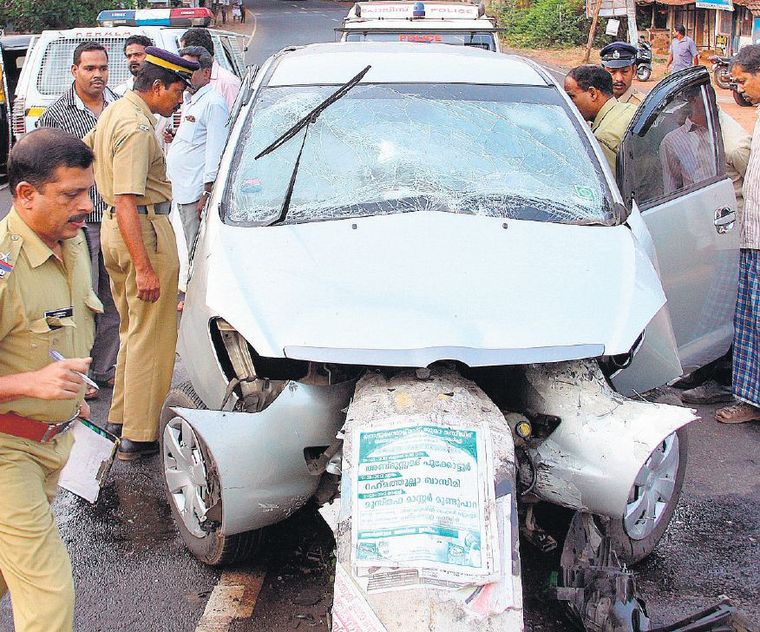Malayalam cinephiles almost lost their favourite on-screen wit when actor Jagathy Sreekumar was laid low by a harrowing road accident on March 10, 2012. Jagathy—as he is popularly known—was on his way to a film location in Coorg on the Kerala-Karnataka border when his vehicle rammed into a median strip on a bend in the road near Kozhikode.
The accident at the crack of dawn left the actor with multiple injuries to his head, chest and abdomen. The 70-year-old thespian, who had ruled the realm of comedy in Mollywood through versatile roles in over 1,100 films, has been mostly away from tinsel town for the last nine years as he is still recuperating from the cruel twist of fate.
Anil Kumar, who drove Jagathy’s car on the fateful day, distinctly recollects the brutal crash that occurred on one of the most perilous stretches of the National Highway 66 (erstwhile NH 17). “It all happened in a split second. I heard a sound and the moment I turned to one side, the car hit the median,” he says.
Kumar, who has recovered from his injuries and still works as a chauffeur in the cinema industry, however, puts partial blame on the median strip which, he claims, had no reflectors. “It was still dark. There were no reflectors on the divider. Also, there were no street lights in the vicinity,” he says, pointing to one of the oft-neglected pitfalls in road infrastructure.
The median strips, meant to streamline turbulent traffic and avert chances of a head-on collision, turn into death traps for commuters when installed without following safety guidelines. The speeding vehicle either rams into a divider that appears from nowhere or hits the lip of the median strip, flips and rolls into oncoming traffic. Though the finger of blame in most such cases is pointed at the man behind the wheel, there are reasons beyond his control, too.
Poor visibility coupled with lack of proper reflectors on the median strip is a recipe for disaster. In some cases, high beams of oncoming vehicles or glaring lights from roadside shops blind the driver temporarily and he fails to spot the unanticipated median head in time. Equally hazardous are thick bushes and untrimmed plants on median strips, which hide drivers’ visibility.
“As per the Indian Road Congress specifications, medians should be provided only if the road has a minimum width, and there should be enough space on both sides to ensure smooth passage of vehicles,” says T. Elangovan, executive director, Kerala Road Safety Authority. On curves, the median should be placed only if the road is at least 12m wide, he says.
The width of the median itself is important as a wide median increases visibility. As per IRC guidelines, the optimum width of a median is five metres and the minimum width in urban areas is 1.2m. Elangovan admits that many of our roads have medians that are just 45cm to 60cm wide, which pose serious safety hazards. “In cities and urban areas, there would be enough light on the road, but if we install such low-width medians on highways, many a time the driver would fail to notice them, especially on curves,” he says.
High-width medians, too, if not marked by reflective tapes, could become difficult to spot, especially at night or during heavy rains. “Usually, a white line (edge marking) in 10cm thickness is provided along the median, and studs (cat’s eyes) are pasted on it. It gives a jerking effect to the vehicles once they move closer to the divider,” Elangovan says, adding that reflectors in red and yellow colour could be installed on the edge of the median itself.
Elangovan further adds that the median strip, which usually accommodates installations like lamp poles and electric posts, should have a covering space of at least 30cm on both sides of the pylons, lest vehicles carrying protruding goods should hit them, leading to accidents. “The proper maintenance of the median is the responsibility of the road-owning agency,” he says.
In February this year, 14 people died after a minivan hit the median strip, jumped off it and collided with an oncoming truck on the Hyderabad-Bengaluru highway. In a similar accident last year on the Coimbatore-Salem highway, a truck rammed into the median strip and hit a Kerala RTC Volvo bus heading to Kochi, killing 20 people. These high-casualty accidents apart, a lot of blood is being spilled on our highways, with raised medians playing a villainous role.
Road safety expert and Indian Institute of Road Safety director Upendra Narayan believes that ignorance is a major reason for unscientific road infrastructure in India. “Many of the foreign countries use forgiving and collapsible water-filled plastic barriers. However, we still use solid concrete medians which will not break up even when the road gets damaged,” says Narayan. According to him, thermoplastic paint marking is more than enough to segregate traffic in areas like intersections.
In most cases, it is drivers who are not familiar with the road terrain that fall victim to median crashes, like tourists and pilgrims. However, many measures can still be taken to mitigate such mishaps. “As per IRC guidelines, high intensity, orange, warning blinkers should be installed 100m before the median head begins and retro-reflective high-intensity grade signboards should be set up. Also, repeated warning stripes can be drawn across the road using thermo-plastic paint,” Narayan says.
If all these fail to reduce accidents, he says, soft humps can be erected on the road; the humps should be 4m wide and have a maximum height of 20cm in the centre. “All structures on the road should be forgiving and collapsible,” he says.
Installation of high mast lights at intersections, setting up and proper maintenance of street lights, regular eviction of encroachment in areas where the central median begins are some of the other measures that can lessen the accidents caused by median strips, says the road expert.
The ministry of road transport and highways has already issued a set of guidelines, directing that all multi-lane highways be provided with depressed or flush medians and that the existing raised medians, especially in open country or rural areas, be replaced with them. For narrow medians, as generally provided in urban areas, the ministry suggests New Jersey-type concrete crash barriers with anti-glare screens.
However, these guidelines do not reach the roads as several vested interests are involved in road construction and maintenance, says Narayan. He alleges that the sector is rife with corruption and fund misuse. “In many cases, the roads are designed unscientifically with exaggerated estimates so that the contractor gets enough benefit and many other middlemen earn a fair amount as commission,” he says. He signs off by saying that the road engineer should be named as co-accused in accidents caused by poor infrastructure.



